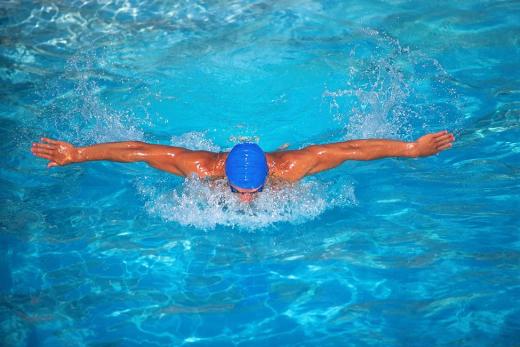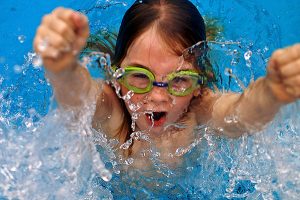It has been estimated that up to 65 percent of competitive swimmers will experience a problem with their shoulder at some point in their careers. This is not surprising when you consider a competitive swimmer may swim 6-8 miles a day and easily hit up to one million strokes per year. Put this together with the fact that the shoulder complex is very mobile, and it is no wonder there are high incidents of overuse syndromes and other biomechanical abnormalities.

What is swimmers shoulder?
Swimmer’s shoulder is the term used to describe the problem of shoulder pain in the competitive swimmer. Swimming is an unusual sport in that the shoulders and upper extremities are used for locomotion, while at the same time requiring above average shoulder flexibility and range of motion (ROM) for maximal efficiency. This is often associated with an undesirable increase in joint laxity. Furthermore, it is performed in a fluid medium, which offers more resistance to movement than air. This combination of unnatural demands can lead to a spectrum of overuse injuries seen in the swimmer’s shoulder, the most common of which is rotator cuff tendinitis. As the shoulder is pushed to its limits in terms of strength and endurance, the rotator cuff muscles generally fatigue before the power muscles, allowing micromotion and subluxation of the humeral head. This, in turn, decreases stroke efficiency, while leading to injuries of the rotator cuff, biceps tendon, and glenoid labrum.
Superior subluxation of the humeral head is particularly problematic as it can impinge the rotator cuff tendons against the acromion above, leading to tendinitis and/or tears. The overlying subacromial bursa (also referred to as the subdeltoid bursa) often becomes inflamed, leading to painful bursitis.
How do you avoid swimmers shoulder?
One of the most important things for every athlete to know is the difference between normal muscular soreness and fatigue vs. early symptoms of pathology (such as decreased range of motion, weakness, pain.) If the symptoms seem abnormal, try to determine any contributing factors such as changes in intensity, distances, or stroke mechanics. If a swimmer continues to work through and ignore the pain, the inflammatory response will increase and make the pain more global. This makes it harder to pinpoint a diagnosis and focus the treatment on the source of the problem.
What is the anatomy involved?
The shoulder girdle is made up of 3 bones (the scapula, clavicle, and proximal humerus), 2 joints (the glenohumeral and acromioclavicular joints), and numerous ligaments, muscles, and tendons. The subacromial bursa overlies the rotator cuff and can provide it with some mechanical protection from the bony acromion above in the face of impingement.
The key ligaments are the glenohumeral ligaments (inferior, middle, superior), which are thickened regions of the joint capsule, of which the inferior glenohumeral ligament is most important. Their role is to help stabilize the glenohumeral joint, in support of the rotator cuff muscles.
The key muscle group of the shoulder is the rotator cuff, made up of (from anterior to posterior) the subscapularis, supraspinatus, infraspinatus, and teres minor. The primary role of the rotator cuff is to function as the dynamic and functional stabilizer of the glenohumeral joint. The long head of the biceps tendon, located between the subscapularis and supraspinatus, also assists the rotator cuff in stabilizing the glenohumeral joint. These muscles and their tendons can be overused and injured in shoulder dominant activities such as swimming, with the most commonly injured portion of the cuff being the supraspinatus. On the other hand, the “power muscles” of the shoulders, including the latissimus dorsi, pectoralis, and deltoid, are responsible for moving the arm through space or water, but only infrequently sustain significant injury.
Finally, the trapezius, levator scapulae, rhomboids, and serratus anterior muscles stabilize and position the scapula and shoulder girdle, and are therefore very important to the swimming stroke. Without a stable platform from which to work, the shoulder and arm cannot function efficiently.
How is it diagnosed?
History
Pain associated with the condition
- Initially, the pain is only noted during or immediately after swimming.
- As the athlete tries to swim “through the pain,” it may worsen to the point where it affects nonswimming shoulder activities and might eventually be noted at rest or at night.
- When the athlete finally stops swimming because of the pain, the condition often improves but recurs with a return to swimming if the rotator cuff has not been specifically restrengthened.
- The character of the pain in swimmer’s shoulder is similar to that of rotator cuff pain. The pain is often poorly localized and felt to be deep within the shoulder.
- On occasion, the pain can be associated with a particular position or phase of the stroke.
- A reproducible click or painful catch should alert the examiner to the possibility of a glenoid labral tear.
- They may describe the pain as being deep, localized to the posterior aspect of the shoulder. Less commonly, they occasionally localize the pain anteriorly or at the deltoid insertion area of the upper arm. Pain characterized as such is consistent with rotator cuff tendinitis, the most common underlying cause of pain in swimmer’s shoulder.
Physical Exam
Observe both shoulders for any asymmetry, particularly in scapular position, or rotator cuff muscle mass (atrophy).
- Range of motion
- Check the ROM of both shoulders, comparing one side to the other.
- In most swimmers, both internal rotation (IR) and external rotation (ER) are increased as compared to the general population.
- Check shoulder strength
- Assess the strength of the rotator cuff by resisting internal rotation (subscapularis) and external rotation (infraspinatus, teres minor) with the shoulder in the neutral position (at the side) and the elbow flexed to 90°.
- Early on, the above tests may only produce pain; however, in advanced cases, weakness in the involved muscle, most commonly the supraspinatus, may be noted.
- Check shoulder stability
- In most swimmers’ shoulders, a mild-to-moderate increase in laxity is noted, indicating multidirectional laxity. Occasionally, this can lead to symptomatic instability in which the swimmer complains of the shoulder subluxing or shifting with use.
- Check joint laxity
- Assess inferior laxity by identifying the presence of a sulcus sign. This is completed by pulling the arm inferiorly, while checking for a gap or sulcus between the humeral head and lateral edge of the acromion, indicating inferior subluxation of the humeral head.
- Grade 1 – Less than 1 finger breadth (< 1 cm)
- Grade 2 – One finger breadth (1-2 cm)
- Grade 3 – Greater than 1 finger breadth (> 2 cm)
- Compare to the opposite shoulder (should be similar, except following unilateral traumatic injury).
- Check for generalized ligamentous laxity (GLL) in other joints (eg, hyperextension at elbows and knees, thumb to forearm test, middle finger hyperextension to forearm). Generalized ligamentous laxity indicates a significant amount of inherent joint laxity related to the individual’s collagen composition and is more commonly found in females than males. Multidirectional instability (MDI) is more difficult to manage in the presence of GLL.
- Assess inferior laxity by identifying the presence of a sulcus sign. This is completed by pulling the arm inferiorly, while checking for a gap or sulcus between the humeral head and lateral edge of the acromion, indicating inferior subluxation of the humeral head.
- Check for labral tear
- A labral tear is suggested when a painful click is noted during the recovery phase of the any overhand stroke. Often, the swimmer can reproduce this click during the exam.
How is it treated?
 The key to injury prevention and rehabilitation is strength and conditioning. Due to the unstable nature of the shoulder, a strong and stable scapula (shoulder blade) is a necessity. Scapular weakness can contribute to an abnormal scapulohumeral rhythm (faulty stroke) and put increased stress on the rotator cuff and biceps. Two areas to pay special attention to are the internal rotators of the shoulder and the scapular stabilizers, which have been shown on EMG studies to be more prone to fatigue in freestyle swimmers. See the exercises below for some strengthening suggestions.
The key to injury prevention and rehabilitation is strength and conditioning. Due to the unstable nature of the shoulder, a strong and stable scapula (shoulder blade) is a necessity. Scapular weakness can contribute to an abnormal scapulohumeral rhythm (faulty stroke) and put increased stress on the rotator cuff and biceps. Two areas to pay special attention to are the internal rotators of the shoulder and the scapular stabilizers, which have been shown on EMG studies to be more prone to fatigue in freestyle swimmers. See the exercises below for some strengthening suggestions.
Another thought to minimize risk of injury is to be cautious with stretching. Most swimmers are not lacking flexibility and actually have a tendency to by hypermobile. Try to avoid partner stretching, which has a tendency to be too aggressive. A gentle 5-10 minute upper extremity warm-up should be enough to increase blood flow and prepare the muscles for a workout. Occasionally a swimmer may develop some tightness in the posterior shoulder capsule that can be a source of pain.
Will I make myself worse by swimming with pain?
The sooner a potential problem is identified and addressed, the better the chance for a quicker and healthier recovery. Remember, you need to pay attention to your body. If a swimmer continues to work through and ignore the pain, the inflammatory response will increase and make the pain more global. This makes it harder to pinpoint a diagnosis and focus the treatment on the source of the problem.
